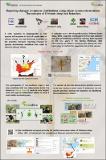Por favor, use este identificador para citar o enlazar a este item:
http://hdl.handle.net/10261/192298COMPARTIR / EXPORTAR:
 SHARE
BASE SHARE
BASE
|
|
| Visualizar otros formatos: MARC | Dublin Core | RDF | ORE | MODS | METS | DIDL | DATACITE | |

| Título: | Reporting changes on species distributions using citizen science observations: The example of Trithemis kirbyi and Natusfera |
Autor: | Perich Prujà, Aina; Leahy, Kristian; Piera, Jaume CSIC ORCID | Fecha de publicación: | 4-feb-2019 | Editor: | Sociedad Ibérica de Ecología | Citación: | XIV Congreso Nacional de la Asociación Española de Ecología Terrestre (2019) XIV Congreso Nacional de la Asociación Española de Ecología Terrestre (2019) |
Resumen: | A critic question in biogeography is how species will response in front of current rates of climate change: we may find many examples in the scientific literature reporting changes in species distributions worldwide that could be linked to climatic effects. A particular case is the dragonfly species Trithemis kirbyi Sélys, 1891, originally distributed in Africa and southern Asia and associated to arid areas, that has been reported in the last years in the Iberian Peninsula. New observations in northern territories are among the most interesting to confirm the expansion rate of this species. In this sense, the participation of non-academic experts that may contribute with new observations (what it is known as citizen science) could be very helpful, since this type of collaboration allows to cover a much wider monitoring area. The number of potential observations (and the covered area) may increase much more if volunteers do not require previous training nor expertise on identifying the reported observations. As an example, in this contribution we report provably the northernmost observation of Trithemis kirbyi in Catalonia (in the population of Albanyà, near the French borderline) using the citizen science platform Natusfera. This platform allows collaborative identification of the reported observations. We believe that this type of collaborative platforms could be used extensively to monitoring changes on species distributions, being a complementary tool for biogeographic studies | Descripción: | 1st Iberian Ecological Society Meeting (2019); XIV Congreso Nacional de la Asociación Española de Ecología Terrestre (AEET), Ecology: an integrative science in the Anthropocene, 4-7 February 2019, Barcelona, Spain | URI: | http://hdl.handle.net/10261/192298 |
| Aparece en las colecciones: | (ICM) Comunicaciones congresos |
Ficheros en este ítem:
| Fichero | Descripción | Tamaño | Formato | |
|---|---|---|---|---|
| Perich_et_al_2019_poster.pdf | 8,24 MB | Adobe PDF |  Visualizar/Abrir |
CORE Recommender
Page view(s)
193
checked on 23-abr-2024
Download(s)
37
checked on 23-abr-2024
Google ScholarTM
Check
NOTA: Los ítems de Digital.CSIC están protegidos por copyright, con todos los derechos reservados, a menos que se indique lo contrario.
